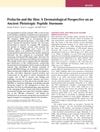Skin Organ Culture: Why?
April 1987
in “
International Journal of Dermatology
”
TLDR Skin organ culture helps us understand skin biology and diseases better.
The document discussed the use of skin organ culture as a method for studying various aspects of dermatology, including the growth and development of skin tissues, the effects of different substances on skin, and the interactions between skin and pathogens. This method allowed researchers to observe skin behavior in a controlled environment, providing insights into skin physiology and pathology. The paper highlighted the historical development of organ culture techniques and their applications in dermatological research, emphasizing their importance in advancing the understanding of skin biology and disease mechanisms.


